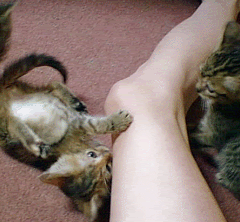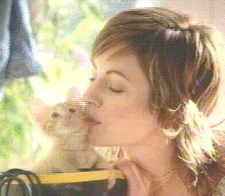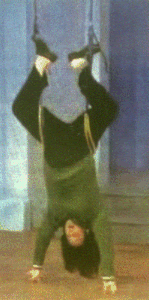 www.thoseshirts.com
www.thoseshirts.com
Posted on 06/29/2007 8:02:15 AM PDT by DogByte6RER
Scientists believe cats 'sort of domesticated themselves'
THE WASHINGTON POST
June 29, 2007
WASHINGTON – Your hunch is correct. Your cat decided to live with you, not the other way around. The sad truth is, it may not be a final decision.
But don't take this feline diffidence personally. It runs in the family. And it goes back a long way – about 12,000 years, actually.
Those are among the inescapable conclusions of a genetic study of the origins of the domestic cat, being published today in the journal Science.
The findings, drawn from the analysis of nearly a thousand cats around the world, suggest that the ancestors of today's tabbies, Persians and Siamese wandered into Near Eastern settlements at the dawn of agriculture. They were looking for food, not friendship.
They found what they were seeking in the form of rodents feeding on stored grain. They stayed for 12 millennia, although not without wandering off now and again to consort with their wild cousins.
The story is quite different from that of other domesticated animals – cattle, sheep, goats, horses, and dogs, cats' main rivals for human affection. It may even provide some insight on the behavior of the animal that, if not man's best friend, is certainly his most inscrutable.
“It is a story about one of the more important biological experiments ever undertaken,” said Stephen O'Brien, a molecular geneticist at the National Cancer Institute's laboratory in Frederick, Md., and one of the supervisors of the project.
“We think what happened is that cats sort of domesticated themselves,” said Carlos Driscoll, the University of Oxford graduate student who did the work, which required him, among other things, to befriend feral cats on the Mongolian steppes.
There are today 37 species in the family Felidae, ranging from lions through ocelots down to little Mittens. All domestic cats are descended from the species Felis sylvestris (“cat of the woods”), which goes by the common name “wildcat.”
The species is indigenous to Europe, the Middle East and East Asia. The New World, Japan and Oceania lack wildcats. Their closest counterpart in North America is the lynx.
There are five subspecies of wildcats and they look very much like many pet cats, particularly nonpedigree ones. The Scottish wildcat, for example, is indistinguishable from a barn cat with a mackerel tabby coat. These animals, however, are true wild species. They are not escaped pets that have become “feral,” or reverted to the wild.
Driscoll and his collaborators, who included Oxford zoologist David Macdonald, took blood samples and ear punch biopsies from all wildcat subspecies, and from fancy-breed cats, ordinary pet cats, and feral cats. They analyzed two different kinds of genetic fingerprints.
One was nuclear DNA, which carries nearly all of an animal's genes and reflects inheritance from both parents. The other was mitochondrial DNA, which exists outside the cell nucleus, carries only a few genes, and descends through the generations only from the mothers, never from fathers.
Both fingerprints showed that domesticated cats all around the world are most closely related to the wildcat subspecies (called lybica) that lives in the Near East.
One might think that people in each region would have domesticated their local wildcats. In that case, European pet cats today would genetically most closely resemble European wildcats and Chinese cats would be descended from East Asian wildcats. But that isn't the case.
Why not?
Genetics can't answer the question, but history and archaeology can provide a good guess.
Large-scale grain agriculture began in the Near East's “Fertile Crescent.” With the storage of surplus grain came mice, which fed on it and contaminated it.
Settled farming communities with dense rodent populations were a new habitat. Wildcats came out of the woods and grasslands to exploit it. They may have lived close to man – but not petting-close – for centuries.
Eventually, though, natural selection favored individual animals whose genetic makeup by chance made them tolerant of human contact. Such behavior provided them with them with things – a night indoors, the occasional bowl of milk – that allowed them to out-compete their scaredy-cat relatives in town.
“she goes thru the house making this loud throaty cry”
Our Siamese does that at night. She carries her small stuffed toy through the house doing that weird yowl from her throat. We thought she was telling us “it’s time to go to bed!” because it’s always around that time. But maybe it’s a hunting-related thing.
Yes.
He’s a brown tabby, and if you make the mistake of letting him sleep too long, he’ll keep you awake all night to help him chase down morsels.
My cat lets me know that she’d take me down if her crunchy dish weren’t regularly tended by the servants.
She even backs it up with reminder nips to the Achilles tendon.
And when I trip over something, she races over not to see if I’m okay, but to see if I’m hurt enough for her to take down.
Spoken like a true cat person! I have three myself.
Oh, I can see where the inspiration could come from. I’ve had pets that like to sleep during the day and want to be played with at night too.
NiMH dropped off a LIVE rabbit in the kitchen.
He then sat and excitedly yipped at us as we chased the rabbitoid miscreant around the kitchen.
This doesn’t include the myriad squirrels and chipmunks he’s brought to us.
Oh, I was referring to the same set, just looking for the exact exclusion. No scales either. I guess furballs don't equal cud. :)
Rainbow Bridge. I’ll meet Homer 1, Homer 2, and Duchess.
NiMH is quite a character.
He was born outside from a feral mother.
But he likes his indoor amenities.
He just prefers being outside, at least until it rains, or snows, or the big rabbit looks threatening.
Not going to do that.
The cat waits by the door if we do that. He bolts the first chance he gets. When he was 6 months old, we spent at least 3 evenings a week trying to chase him down and carry him back. If he gets really frustrated he will "mark" places in the house.
Siberian cats supposedly naturally lack the gene for the saliva protein that irritates some humans so. Allegedly 70% of allergic people can tolerate a Siberian cat. You could visit a Siberian cattery and see if you’re one of the lucky ones.
LOL. I DO learn a lot on freerepublic. I should have stopped when you suggested to NOT look it up.
Sorry to hear about your loss MissEdie.
I'm so sorry to hear that. Before I got Squeek I adopted Molly-Berry thru pet rescue and only had her for 6 weeks before I had to put her down due to liver cancer. her total cost to me for the brief time she was with me including rescue fees was around $800.
I don't mind the monetary outlay for her because she was such a wonderful cat and friendly to all who came into my house. I take solace in the fact that she had finally arrived at a home that appreciated her presence and in her last 6 weeks of life she was loved.........

Whoa...  Momma!
Momma!
Now, that's...  just down right kinky!
just down right kinky!
What so kinky...  about kissing a little fuzzy wuzzy?
about kissing a little fuzzy wuzzy?
Gadzooks! I am...  speechless...
speechless...
Just like...  a man!
a man!
Look who needs...  a booster dose of Bond. James Bond.
a booster dose of Bond. James Bond.
I...  need a dose of something!
need a dose of something!
Yeah, a dose of salts...  with a dump truck chaser!
with a dump truck chaser!
I remember reading somewhere that cats, unlike dogs, form greater bonds with a place, as opposed to other people. Maybe this comes from being solitary hunters, as most great cats tend to be, or the fact that most great cats also tend to roam over fairly large territories.
I know that moving can be a terrible experience for a cat.
Mark
For reasons unknown, Hawaii forbids bring a Bengal into the state. Dunno what the big deal is. My brother's wife has a couple and loves them dearly.
My cats are named after two Chi-Com dictators. Mao, which means the animal that makes the meow sound, and Hu, which means tiger. Actually, her full name is Xiao Hu, small tiger..
Disclaimer: Opinions posted on Free Republic are those of the individual posters and do not necessarily represent the opinion of Free Republic or its management. All materials posted herein are protected by copyright law and the exemption for fair use of copyrighted works.